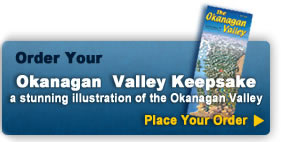KELOWNA History
The familiar Central Okanagan Landscape has a long and diverse history.Originally settled by Interior Salish speaking people, the region’s plants, animals and other resources provided the means for a unique cultural tradition.In this setting, the Native people followed seasonal cycles of food fathering, hunting and ceremonial life.
The seasonal cycles took on a different focus when Catholic missionaries pre-empted land near Mission Creek in 1860.Today, the Father Pandosy Mission is a provincially recognized historic site.
Those early pioneer years focused on an industry that fed the Cariboo gold miners and other early settles – cattle ranching.The orchard landscapes began to take shape more than three decades after Father Pandosy and the early ranching pioneers arrived.With a new rail spur line to Okanagan Landing at the head of Okanagan Lake, the CPR sternwheelers made regulars stops at Kelowna, a brand new town site laid out in 1892.Between 1904 and 1914, thousands of acres of cattle range and grain fields were shifted to irrigated orchards.In a decade the Valley turned from brown to green.
The City of Kelowna was incorporated in 1905 and, as the town grew, one by one the older wooden buildings along Bernard Avenue were torn down or moved to make way for new brick structures that better reflected the town’s strengthening economy.
While orchards formed an important part of the economic base, pioneers experimented in earnest with other crops.Perhaps one of the most promising of those was tobacco.At one point the Kelowna area boasted vast fields of tobacco and the industry gave birth to “Kelowna Pride” cut and cigar tobaccos.
Kelowna experienced modest growth through the two World Wars, but dramatic change was on the way.That change came in the form of the Okanagan Lake Floating Bridge, opened by Premier W.A.C. Bennett and Princess Margaret in 1958.Other highway improvements – the Hope-Princeton Highway and the Rogers Pass – began to focus the area’s economy more around tourism.That shift was further strengthened by the opening of the Coquihalla Connector.
Although the tree fruit industry has cast the dominant agricultural look to the Valley’s landscape, since the 1970’s, the wine industry has brought a new complexion to the scene.Today, more than 6000 acres have been planted to grapes for the Valley’s wine production; and for the first time red grape acreage has exceeded white grape plantings.
The Valley’s wine industry began in the late 1920’s but it took a significant turn toward the production of high quality viniferous grape wines in the 1970’s and 1980’s.Since then, the province’s wines have won hundreds of national and international medals.
Much of the Okanagan Region’s history is available to the public through the exhibitions and public programs of the area’s Museums.The Okanagan Heritage Museum began in the 1930’s and helps visitors explore the Valley’s rich human and natural history themes.From First Nation artifacts through exploration and pioneers settlement, the displays bring stories to life.
In the historic Laurel Packinghouse, Kelowna’s first designated heritage building (built in 1917), visitors can see a clear picture of the province’s tree fruit history at the BC Orchard Industry Museum.Here, exhibition themes help illuminate everything from picking and packing to irrigation and transportation.
Also in the Laurel Packinghouse is the BC Wine Museum where photographs and artifacts tell the province’s wine industry history beginning in the 1920’s.That story is brought right up to date with wine tasting from the Museum’s specialty VQA (Vintners Quality Alliance) wine shop.
The Okanagan Military Museum began in the 1980’s and is aptly located in Kelowna’s Memorial Arena.Dedicated to capturing the history of the Valley’s various military regiments, displays walk you through compelling stories from the Boer War, through World Wars I and II, the Korean conflict and bring the story right up to date with Canada’s current military activity.
There is a lot to experience in this beautiful place we live – Welcome!
Wayne Wilson,
Executive Director, Kelowna Museums
Executive Director, Kelowna Museums



